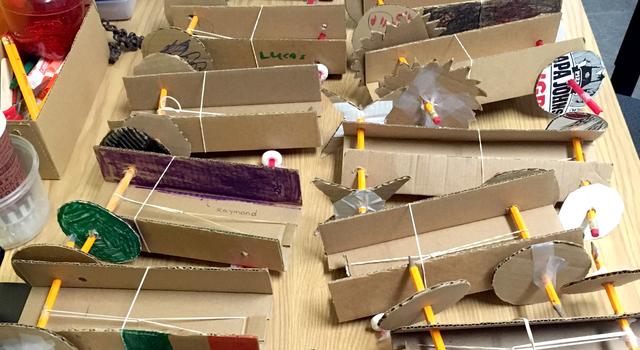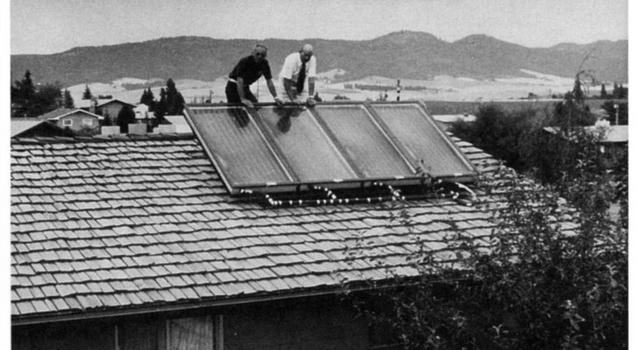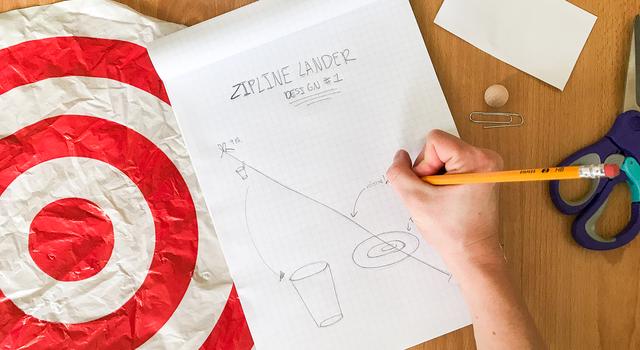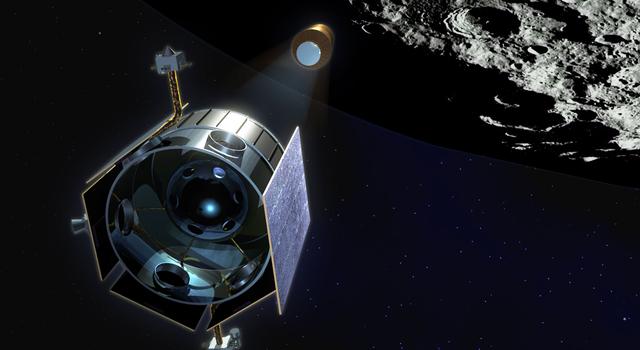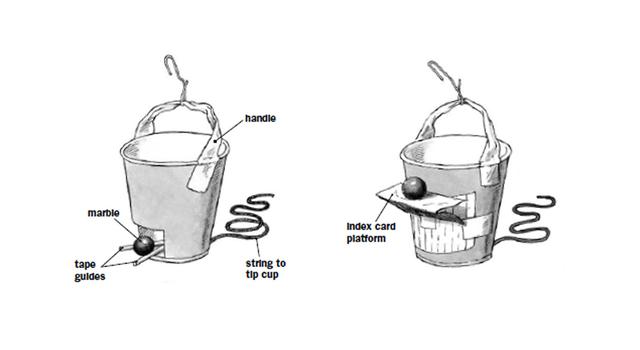Classroom Activity
On Target
Activity Notes
Overview
In this challenge, kids modify a paper cup so it can zip down a line and drop a marble onto a target. Students will follow the engineering design process to modify a cup to carry a marble down a zip line; attach a string to tip the cup; test their cup by sliding it down the zip line, releasing the marble, and trying to hit a target on the floor; and improve their system based on testing results.Materials
Management
- Read the challenge sheet and activity details to become familiar with the activity.
- Gather the materials listed above.
- Set up a sample zip line.
- Put a handle and paper clip on a cup. (In other words, don't make a door or platform for the marble.)
- Optional: Print a picture of the Lunar Crater Observation and Sensing Satellite (LCROSS) from the NASA website.
Procedures
- Introduce the challenge (5 minutes)
- Tell kids how NASA used the LCROSS spacecraft to search for water on the moon.
To see if there’s water on the moon, NASA is sending the Lunar Crater Observation and Sensing Satellite (LCROSS) hurtling into a crater near the moon’s South Pole. The collision will send up a plume of dust and gas over 6 miles (10 km) high. Scientists will study this plume to see if there are any signs of water in it. - Show kids your zip line. Hang the cup on the zip line, using a hook made of a paper clip. Show kids how the cup travels down the zip line. Tell them:
Today you’ll turn a paper cup into something that can zip down a line and drop a marble onto a target. Just as the success of LCROSS depends on hitting the crater exactly, success in today’s activity depends on being able to hit the target accurately and consistently. As you test your design, you’ll find ways to make it work better. Improving a design based on testing is called the engineering design process. - Brainstorm and design (10 minutes) - Distribute the challenge sheet. Discuss the questions in the "Brainstorm and Design" section.
- How will you modify the cup so it can carry a marble down a zip line and also drop it onto a target?
If the marble rides inside the cup, kids need to cut a door. If it rides outside the cup, kids need to make a platform, shelf or holder. All systems need a way to tip the cup at the right instant. - How will you remotely release the marble from the cup?
Attaching a string on the uphill side of the cup, opposite the door or platform, will enable kids to tip the cup effectively. - When do you need to launch the marble so that it will hit the target?
Kids should stand near the top of the zip line, holding one end of the string. When the cup reaches the “drop zone,” kids should jerk the string. The marble will be ejected and fall toward the target. Note: When dropped, the marble keeps moving forward as it falls. Kids will need to factor in this forward motion as they decide when to release the marble. - Build, test, evaluate and redesign (35 minutes)
- Instruct students to follow the directions in the "Build" section of the challenge sheet.
- Set up a zip line - Tie 6 feet (1.8 m) of the smooth line to two objects (e.g., two chairs or a table and chair). Make sure it’s stretched tight and that one end is about 20 inches (50 cm) below the other.
- Figure out how to modify the cup to carry the marble down the zip line - Will it travel inside the cup? Outside the cup on a platform? Underneath?
- Add a remote release - Decide how you will tip the cup at just the right instant to launch the marble toward the target.
- Clip the cup to the zip line - Figure out how to hook the cup onto the zip line so it slides easily.
- Test, evaluate and redesign - Place the target near the end of the zip line. Send down the cup and try to hit the target with the marble using the remote release. How close did you get? See a way to improve your design?
- Help kids with any of the following issues. For example, if:
- The cup goes slowly down the zip line - Make sure the cup slides freely. Also, check the steepness of the zip line.
- The remote release line is too short - Kids should estimate where the "drop zone" on the zip line is and make the remote release line at least that long.
- The marble doesn't eject cleanly - Enlarge the opening or unblock the platform. Also place small rolls of tape in the bottom of the cup to guide the marble toward the opening.
- The marble accidentally falls out of the cup or off the platform - Adjust the tilt of the cup, if necessary. Also, kids can roll small tubes of tape to hold back the marble.
- The marble misses the target - Check that the door or platform doesn't interfere with the marble. Also, make sure kids are releasing the marble before the cup is above the target.
- Discuss what happened (10 minutes) - Have kids show each other their modified cups and talk about how they solved any problems that came up. Emphasize the key ideas in the challenge by asking the discussion questions below.
Discussion
- What parts of your design were most important in getting the marble to hit the target?
Getting the marble to eject cleanly from the cup and the timing of release are important. - After testing, what changes did you make to your cup?
(Answers will vary.) - Describe the way your marble moved after you ejected it.
It moved both downward and forward. This combination produced a curved path called a trajectory. - Newton's First Law states that an object in motion continues in straight-line motion until acted on by force. How did the activity demonstrate Newton's First Law?
As it traveled down the zip line, the marble built up speed. Once launched, it kept going at that speed until a force, such as gravity pulling it down or the floor stopping it, acted on the marble. - How is your challenge similar to NASA's LCROSS mission to the moon?
Both you and NASA devised a system that caused something to crash into a surface. Also, both setups have a remote triggering device, although LCROSS’ is radio controlled. Finally, both the marble and the spacecraft have a forward and downward component to their motion.
Assessment
Extensions
- Watch a video about LCROSS
The NASA website has a four-minute video that describes the Lunar Crater Observation and Sensing Satellite (LCROSS) mission and uses animation to show what happens when the spacecraft strikes the moon’s surface. Watch the video. - Analyze an object's motion as it follows a trajectory
To show that an object’s speed is constant as it follows a trajectory (a curved path), take a video of the marble falling from the cup. Play it back on a TV or computer one frame at a time. Tape a transparency to the TV or computer screen, and make marks from frame to frame, measuring the horizontal distance traveled by the marble each time. Kids will see that the distance traveled in each frame is constant.





